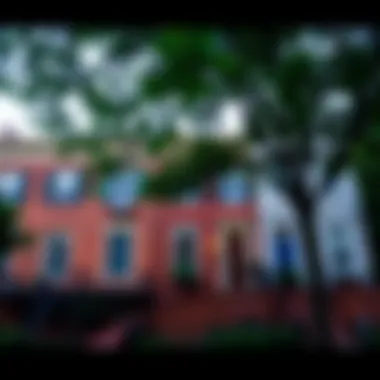Renting a House in Washington, D.C.: A Complete Guide


Intro
Renting a house in Washington, D.C. can feel like navigating a maze. With its rich history, diverse neighborhoods, and unique cultural vibes, it’s crucial to be informed. This guide aims to shed light on the many facets of the rental process, from understanding the architectural styles that define the city to parsing through legal considerations. If you’re a real estate enthusiast or simply looking for a change of scenery, you’ll find this information both relatable and invaluable.
Featured Homes
Architectural Styles
D.C. is a melting pot of architectural styles that reflect its storied past and modern developments. From the stately Georgian-style homes of Georgetown to the sleek lines of contemporary townhouses in Navy Yard, there’s a something for everyone. The distinction of these homes isn’t just in their designs. They each tell a story about the era they were built in.
- Victorian: Brightly painted façades and intricate detailing are hallmarks of these charming houses, prevalent in neighborhoods such as Capitol Hill.
- Modernist: In parts like the H Street Corridor, minimalist homes showcase clean lines and an emphasis on function over form.
Unique Design Elements
In selecting a rental, keep an eye out for design elements that enhance the livability of a space. Look for features such as:
- Open floor plans - These create an airy feel, allowing for better light flow.
- Built-in shelves - Not only do they add character, but they also maximize storage.
- Outdoor spaces - Whether it's a small balcony or a backyard, these can provide an essential escape from urban life.
Renters should pay attention to these elements, as they often influence day-to-day life.
"Choosing a rental is more than just picking a place to live; it’s about finding a community that resonates with you."
Incredible Locations
Geographic Highlights
Washington, D.C.'s neighborhoods are as varied as the city’s landmarks. From the vibrant streets of Adams Morgan to the historic aura of Dupont Circle, each area has its unique charm. Consider:
- Cleveland Park: Nestled amidst lush landscapes, this neighborhood offers quiet streets and large homes.
- Logan Circle: Known for its Victorian homes and historic district, it's a picturesque area with a strong sense of community.
Cultural Significance
Living in D.C. means being steps away from some of the world's most important cultural sites. The nearby Smithsonian Museums and the National Mall are just the tip of the iceberg. Each neighborhood is steeped in history, providing a rich backdrop for everyday life. Think about what kinds of activities matter most:
- Art and entertainment: Areas like U Street are packed with music venues and theaters.
- Food scene: Nearby neighborhoods often boast culinary offerings from around the globe, especially in vibrant spots like Union Market.
Exploring these neighborhoods gives renters a glimpse into what D.C. life can truly be.
For additional resources on renting in D.C., consider exploring D.C. Government Housing Resources or perusing forums such as Reddit’s D.C. subreddit.
By thoroughly understanding what the city has to offer, you can better navigate the rental market and make informed choices.
Understanding the Rental Landscape in Washington, D.C.
Navigating the rental market in Washington, D.C. is a bit like trying to catch lightning bugs on a warm summer evening. It requires some patience, the right timing, and a clear understanding of the area. This capital city has a reputation for being bustling and vibrant, but its rental landscape can feel overwhelming for newcomers and locals alike. Knowing the ins and outs of this market is crucial for securing a place that meets your needs without breaking the bank.
Understanding the rental landscape entails grasping the unique characteristics that shape D.C.’s real estate scene. Factors such as political movements, influx of professionals, and local economic conditions significantly influence rental prices and availability. By taking the time to learn about this dynamic environment, renters can make informed decisions that not only fit their wallets but also their lifestyles.
Overview of the D.C. Rental Market
The D.C. rental market is anything but static; it ebbs and flows in rhythm with the seasons, the political climate, and social trends. The city is home to a mix of historic charm and modern living which appeals greatly to a diverse demographic. From young professionals and families to students and retirees, Washington offers something for everyone.
One particularly noteworthy aspect is the rarity of available rental units. As of late 2023, vacancy rates hovered around 5%—lower than the national average. For renters, this means competitiveness is key. The moment you find a property you fancy, you may want to act. Doing so can be the difference between securing that charming two-bedroom apartment or missing out on it entirely.
Rental prices also vary tremendously between neighborhoods, creating a mosaic that reflects the socio-economic diversity of D.C. For instance, areas like Capitol Hill offer historic homes with immediate access to the seat of government, but they typically come with a heftier price tag. In contrast, neighborhoods such as Anacostia, while more affordable, provide a unique character that attracts a wide range of renters looking for community vibe over proximity to the political hub.
Key Trends in D.C. Rental Prices
Riding the waves of rental trends can be tricky, yet it’s essential for any prospective renter. In recent years, one dominant trend is the increase in demand for smaller, pet-friendly apartments and rentals that offer amenities such as fitness centers and rooftop decks. Young professionals are increasingly selective and willing to pay a premium for convenience and lifestyle offerings.
Another trend is the shift in rental prices driven by the ongoing recovery from the pandemic. Many renters had prior to COVID sought the bustle of downtown living, but the trend has shifted towards neighborhoods that present more space and quieter environments, thus driving prices up in certain less traditional neighborhoods.
- The demand for rental properties tops the charts. With so many professionals flocking to the city, landlords often find themselves in a position where they can raise rents or justify high pricing for newly constructed units.
- Longer leases are gaining popularity. Given the uncertainty of the real estate market today, many renters prefer signing longer leases, often two years or more, to lock in current rates even amidst inflationary pressures.
- Remote work influences choices. With more companies offering remote work flexibility, renters are expanding their perimeters, opting for properties that, in years past, would have been deemed “too far” from their offices.


Choosing the Right Neighborhood
Choosing the right neighborhood in Washington, D.C. has a direct impact on your daily life and overall experience as a renter. D.C. neighborhoods vary greatly in terms of amenities, atmosphere, and public services. This selection isn’t merely about finding a decent place to live; it’s also about aligning your lifestyle with the right environment. From casual vibes in bustling hubs to serene landscapes in quieter locations, the neighborhood can shape your routine, social interactions, and community engagements.
It's essential to weigh things like proximity to work, social options, recreational opportunities, and public transport when picking a neighborhood. Perhaps you seek a vibrant dining scene, or maybe a place near parks and historical sites revives your enthusiasm for city living. Finding that perfect mix can lead to greater satisfaction in your rented home.
Comparative Analysis of D.C. Neighborhoods
Washington, D.C. consists of a myriad of neighborhoods, each having its own flavor. It’s akin to walking through a gallery where every painting (or neighborhood) tells a different story. For example, a neighborhood like Adams Morgan is known for its rich nightlife and diverse population, making it a hotspot for younger tenants. In contrast, the more subdued atmosphere of Forest Hills is often favored by families thanks to its spacious homes and parks.
Living in an urban environment like D.C. often means facing trade-offs. Comparing neighborhoods on different metrics such as average rent prices, crime rates, accessibility to services, and overall ambiance can signal where you might want to settle down.
Factors to Consider When Selecting a Neighborhood
When selecting a neighborhood in Washington, D.C., several factors must come into play:
- Commute: Proximity to your workplace can reduce travel stress.
- Safety: Investigate crime rates to ensure you're comfortable.
- Lifestyle: Whether you enjoy the hustle of city life or prefer a laid-back, family-friendly area, knowing your personal preferences is key.
- Amenities: Access to grocery stores, parks, and restaurants can enrich your living experience.
- Public Transport: Consider how easy it is to get around town. Metro access is vital for many residents.
By reflecting on these factors, you'll make a more informed choice aligning with your lifestyle and needs.
Highlighting Popular Neighborhoods
Capitol Hill
Capitol Hill carries weight in D.C. as it’s home to the United States Congress and filled with historic architecture. This area's proximity to national landmarks makes it a prime location for those interested in the political scene or history buffs. The vibrant community is full of events, farmer's markets, and cafes that contribute to a lively day-to-day atmosphere.
One significant aspect of Capitol Hill is its generally family-friendly environment, complemented by ample green spaces including Lincoln Park. However, due to its desirability, rental prices can be on the higher side, making it key to keep a close eye on your budget.
Georgetown
Known for its picturesque waterfront and trendy boutiques, Georgetown seamlessly blends the old with the new. The neighborhood's cobblestone streets appeal to those looking for a mix of history and modern luxury. Georgetown hosts a variety of renowned restaurants and cultural institutions, making it a hotspot for social gatherings.
A unique feature is the historic District of Columbia Canal and its walking trails, perfect for a scenic evening stroll. On the downside, like Capitol Hill, rental costs here can be steep, leading some to consider nearby areas as alternatives.
Woodley Park
Woodley Park offers a more suburban feel while still being part of the city. It’s known for its green spaces, including the picturesque Rock Creek Park, which creates a nice escape from urban bustling. The area attracts families and nature lovers who appreciate the community vibe.
One notable characteristic is the accessibility to various shops and eateries along Connecticut Avenue, making daily life convenient. However, the choice of housing may lean towards more family-sized units, leaving solo renters or couples with fewer options compared to busier neighborhoods.
In showcasing these neighborhoods, prospective renters can better align their choice with personal preferences and lifestyle needs.
Rental Process Explained
Renting a house in Washington, D.C., can be an endeavor fraught with complications, but understanding the rental process is key. This guide breaks down the process into manageable steps that help demystify the journey. In D.C., the rental process involves several elements that can either make or break your renting experience. From finding a suitable property to signing a lease that best fits your needs, every choice carries weight.
The importance of grasping the rental process lies not only in avoiding pitfalls but also in making informed decisions that align with your lifestyle and budget. Renting in a bustling city comes with its intricacies, like understanding the competitive market conditions and having your paperwork in order.
As you navigate through the world of rentals, knowing what to expect allows you to tackle the challenges head-on and makes it easier to secure a place that feels like home.
Finding a Rental Property
Finding the right rental property is often the first and, arguably, the most crucial step in the rental process. The vast rental landscape in Washington, D.C., is diverse and ever-changing, offering a seemingly endless array of options -- some of which you might not even know exist.
Utilizing Online Listing Services
In the digital age, utilizing online listing services is a widely accepted practice for house hunting. Platforms like Zillow, Apartments.com, and Craigslist have essentially become lifelines for prospective renters. With the ability to filter by price, neighborhood, and key features, these services allow renters to tailor their searches.
The drive behind using these platforms stems from their convenience and accessibility. Searching online is not only straightforward, but they also provide a wealth of comparables to help you gauge what’s available in your desired area. However, it's essential to be cautious as the abundance of listings can sometimes lead to misinformation, such as outdated availability or misleading photographs.
One notable advantage is the ability to view neighborhood amenities and traffic data at your fingertips. But be sure to verify listings and, whenever possible, visit potential properties in person to prevent a case of online shock down the line.
Connecting with Real Estate Agents


Another method worth considering is connecting with real estate agents who specialize in rentals in Washington, D.C. These professionals bring not just listings but also invaluable industry insight. Unlike online platforms that might bombard you with information, real estate agents can filter properties based on your unique preferences and needs.
The main characteristic of working with an agent is the personalized approach they offer. They can identify the often subtle differences between neighborhoods and guide you toward properties you might have overlooked if searching on your own. Plus, they can assist in negotiation that could result in better terms than you might secure solo.
While the beneficial aspect is clear, keep in mind that agents often charge a fee, usually equal to one month's rent. Hence, it's vital to weigh this cost against the potential savings and benefits they provide in your search process.
Understanding Lease Agreements
Once you have found a property that catches your eye and are ready to move forward, the next step is understanding lease agreements. A lease is a legally binding document that outlines the terms, rights, and obligations of both the landlord and the tenant. Therefore, comprehending its intricacies is paramount.
Many people overlook the details in lease agreements; however, anything from pet policies to maintenance responsibilities is typically detailed within. Being aware of your rights and restrictions as a tenant can save you a heap of trouble later on.
Reading the lease thoroughly and asking for clarifications on any confusing sections is not just wise but necessary. Make sure you are comfortable with clauses regarding renewals and penalties for breaking the lease.
Ultimately, navigating rental applications and understanding lease agreements forms the backbone of successfully renting a home in Washington, D.C. Being well-prepared provides the confidence you need to make informed decisions during your search.
Navigating Rental Applications
The process of applying for a rental property in Washington, D.C. can feel like navigating a maze. Understanding how to effectively navigate rental applications is crucial for potential renters. This is not just about securing a roof over your head; it’s about ensuring that you are presenting yourself in the best light possible to landlords and property managers.
By grasping the intricacies involved in this process, you increase your chances of approval and avoid unnecessary delays. Awareness of what documentation you’ll need and common pitfalls to watch out for can save you time and effort, enabling you to efficiently transition into your new home.
Preparing Required Documentation
When you set out on the quest to find a rental property in D.C., being organized makes a significant difference. Landlords typically require a specific set of documents to process your application smoothly. Some of the essential paperwork includes:
- Proof of Identity: This can be a passport, driver’s license, or any government-issued ID.
- Employment Verification: A letter from your employer detailing your position and salary can help landlords feel at ease with your financial stability.
- Credit Report: Having a recent credit report handy shows transparency and can ease any concern regarding your financial history.
- Rental History: References from previous landlords weigh heavily in your favor. They can provide insight into your reliability as a tenant.
- Pay Stubs: Typically, landlords like to see a few recent pay stubs to validate your income.
Keep your documents organized and ready to go, as some landlords operate on a first-come, first-served basis. If they see everything is in order upfront, it sets a positive tone for your lease negotiations.
Common Application Mistakes to Avoid
Even with great intentions, applicants can find themselves stumbling over minor yet significant mistakes during the application process. Here are a handful of common pitfalls to dodge:
- Incomplete Applications: Leaving sections blank or failing to provide requested documents can automatically disqualify your application.
- Inaccurate Information: Double-check your income, rental history, and personal details before submission. Mistakes like typos could raise red flags.
- Not Following Up: After submitting your application, it’s a good idea to follow up with the landlord. A polite inquiry can show your interest and commitment.
- Ignoring Deadlines: Each listing has specific application deadlines. Missing these could mean having to start the process all over again.
"A little organization can spare you a lot of headache when navigating rental applications."
In essence, the application phase might seem like a hurdle, but it can be managed with the right preparation and mindfulness. As you embark on this journey, remember that diligence today can lead to a more advantageous rental tomorrow.
For more detailed insights on tenant rights and rental applications, check out resources like Nolo or local government websites for housing advice, such as dc.gov.
Understanding Tenant Rights and Responsibilities
In any rental agreement, understanding the rights and responsibilities of tenants is crucial. It's the cornerstone of a well-functioning landlord-tenant relationship. Without this knowledge, renters in Washington, D.C. could find themselves at a disadvantage when dealing with disputes or misunderstandings. Knowing what you are entitled to, alongside what is expected of you, can alleviate significant stress during the rental process.
Legal Considerations for Renters
Renters in D.C. are protected by a variety of laws designed to safeguard their interests. Understanding these laws can empower tenants and enhance their rental experience.
- Housing Discrimination: The Fair Housing Act prohibits discrimination based on race, color, religion, sex, national origin, disability, and familial status. This means landlords cannot refuse to rent simply because of these characteristics.
- Rent Control: While not all areas of D.C. are rent-controlled, knowing whether a property falls under this category can impact budget planning. D.C. has regulations that require landlords to adhere to specific practices regarding rent increases, ensuring affordability for tenants.
- Retaliation and Eviction: Renters are protected from retaliatory actions by landlords. It’s illegal for landlords to evict, harass, or increase rent against tenants for exercising their legal rights, such as complaining about housing conditions.
- Habitability: All rental properties must meet basic health and safety standards. This includes functional plumbing, heat during winter months, and a safe environment. Tenants can seek legal recourse if landlords fail to maintain these standards.
Important: Always keep copies of your lease and any correspondence with your landlord. This documentation can be invaluable in case of disputes.
Understanding the Security Deposit Policies
The security deposit is typically the first line of defense for landlords to secure against damage or unpaid rent. For tenants, understanding how these deposits work is vital.
- Maximum Amount: In D.C., the security deposit cannot exceed one month's rent. This limitation exists to prevent landlords from overcharging tenants before they even move in.
- Interest on Deposits: Landlords must return the security deposit within 45 days after tenants vacate the property, and they are required to pay interest on the deposit. Hence, not only can you get your money back, but it might earn you a little extra too.
- Proper Deductions: Landlords can only withhold amounts for damages beyond normal wear and tear or unpaid rent. It's essential for tenants to document the condition of the property when moving in and out. Taking photos can help protect your interests.
- Returning the Deposit: If you disagree with any deductions made by the landlord, you have the right to question and appeal these claims. Being well-informed on the process can empower you in negotiations.
Understanding these elements of tenant rights and responsibilities helps create a safer, more transparent renting experience. You not only enhance your ability to navigate the complexities of rental agreements but also ensure that your living conditions are just and fair.
Making Your Rented House a Home


When settling into a new rented house in Washington, D.C., transforming that space into a home becomes an essential part of the experience. While rental properties often come with restrictions on how much you can change the physical space, there are plenty of creative and practical ways to foster a sense of belonging. This transformation not only enhances your day-to-day comfort but also can significantly impact your overall well-being.
Interior Design Tips for Rentals
Designing a rental space can seem daunting, but with the right approach, it can also be quite fun. Here are some tips to help you make your rented house your own:
- Embrace Temporary Changes: Wall decals or removable wallpaper can drastically change the look of your space without leaving any permanent marks. They come in various styles and designs, catering to all tastes.
- Invest in Versatile Furniture: Opt for furniture that serves multiple purposes. A stylish ottoman can double as storage, while a well-placed bookshelf can act as both a decorative piece and a divider for open spaces.
- Layer Textiles: Use rugs, cushions, and throws to add warmth and character. Choose colors and patterns that reflect your style, as textiles can easily be swapped out when you want a change.
- Use Lighting Creatively: Good lighting can work wonders. Floor lamps, table lamps, and even fairy lights can create different moods in your rental. Consider the ambiance you want and tailor your lighting choices accordingly.
"A touch of personal flair turns a house into a sanctuary. Set up your space to reflect who you are."
Establishing a Comfortable Living Environment
Comfort is key when it comes to making your rented house feel like home. Here are some considered approaches to foster a welcoming environment:
- Personal Touches: Hang photographs or artwork that means something to you. It might be a simple family portrait or vibrant cityscapes of D.C. Each piece should tell a story or evoke a memory, creating a unique narrative throughout your space.
- Optimize Your Layout: Plenty of people overlook how important layout can be. Think about how you move through spaces and arrange your furniture to facilitate flow. Uncluttered pathways encourage relaxation and accessibility.
- Greenery and Fresh Air: Adding plants can not only purify the air but also uplift the overall mood of your space. Various low-maintenance options, such as snake plants or pothos, can breathe life into corners and shelves.
- Create Zones: If your rented house is spacious, consider creating different zones for various activities, like a reading nook or a workspace. This separation helps in maintaining focus and promotes a harmonious living environment.
- Invest in Comfort: Don't skimp on essentials like quality bedding or seating. These investments go a long way in establishing a cozy atmosphere where you can unwind after a long day.
By combining thoughtful design and comfort-focused choices, you can create a space that truly feels like home, even amid the hustle and bustle of Washington, D.C. Taking the time to establish your rented house as a personal sanctuary allows you to fully engage with your new surroundings while making each day more enjoyable.
Exploring Lifestyle and Entertainment Options
In the hustle and bustle of Washington, D.C., renting a home goes far beyond just securing a roof over your head. The lifestyle and entertainment options within this vibrant city are vital considerations for prospective renters.
Washington, D.C. is not just a political epicenter but also a cultural mecca. Access to diverse dining experiences, enriching social scenes, and recreational amenities can substantially enhance your living situation. As you ponder over neighborhoods and rental options, you must think about what makes a house a home — that often includes the surrounding lifestyle and available activities that match your interests.
Dining and Social Scene in D.C.
Eating out in D.C. is akin to embarking on a culinary tour. The city is a melting pot of cultures reflected in its eateries. There are upscale restaurants such as The Inn at Little Washington that serve exquisite dishes crafted from local ingredients, alongside food trucks and casual diners like Founding Farmers, where comfort food gets a twist. You’ll find a range to satisfy every palate from Ethiopian to sushi, giving you plenty of options.
Socially, the city thrives on networking and connecting. Bars like The Gibson or The Columbia Room elevate the nightlife experience with craft cocktails and refined settings. This isn’t only about enjoying a night out but also building relationships that can open doors professionally and personally. Thus, the area you select can play a critical part in how active you'll be socially. You won’t want to miss out on happy hours, food festivals, or outdoor concerts that solely depend on your neighborhood's proximity.
Accessing Cultural and Recreational Amenities
When selecting a rental property in D.C., it’s crucial to look at the nearby cultural and recreational options available. The Smithsonian Museums, for instance, offer free admission, making return visits to view art, history, or science a cost-friendly option.
The sprawling National Mall is a playground for outdoor enthusiasts and history buffs alike. You may partake in guided tours or simply enjoy a walk while taking in the iconic monuments like the Lincoln Memorial or the Washington Monument. Meanwhile, locals also cherish smaller parks, such as Meridian Hill Park — perfect for weekend picnics and leisure.
Fitness-minded individuals will appreciate D.C.'s array of gyms and yoga studios, alongside running paths along the Potomac River. Remember, proximity matters. Having a vibrant atmosphere around your rented house can significantly affect your mental and physical well-being.
To wrap it up, understanding the lifestyle and entertainment options in D.C. directly impacts your rental experience. The local dining scene, cultural access, and recreational amenities can turn a simple rental into a fulfilling living experience.
"The place you choose to live shapes your day-to-day reality. Invest not just in a house, but in the life you want to live."
Before you make the big leap of signing that lease, take stock of what options fit your lifestyle. With the vibrant spirit of Washington, D.C. at your doorstep, your renting journey is not just about the space — it’s a pathway toward experiencing life to its fullest.
Ending: Preparing for Your D.C. Rent
Renting a house in Washington, D.C., comes with its own unique set of challenges and opportunities. As such, it is paramount for prospective renters to arm themselves with the necessary knowledge and tools to make informed decisions. The complexities of D.C.’s rental landscape do not merely stem from its dynamic market; the city also presents a myriad of neighborhoods, each with distinct quirks and character.
This guide has taken you through various crucial topics—from understanding the evolving rental market trends to identifying the right neighborhood. Each part of this journey is designed to empower you, the renter. Through informed choices, you can select a residence that not only meets your needs but also enhances your overall lifestyle.
It's essential to take away that preparation is key in this undertaking. Searching for a property isn't just about signing a lease; it’s about making a long-term commitment. Getting acquainted with local median rents, grasping tenant rights, and being aware of neighborhood vibes can save you both cash and hassle down the road.
Equipped with the insights from this guide, prospective renters can navigate challenges with confidence. Preparation also involves gathering documentation for applications and understanding lease agreements, ensuring that your move-in experience is smooth.
"Knowledge is power, especially in the uncertain world of rentals."
As you prepare to dive into the renting process, remember that your new home should reflect your lifestyle and personality—giving you a true sense of belonging in this vibrant city.
Final Thoughts on Renting in Washington, D.C.
Navigating the rental market in Washington, D.C., can feel like walking a tightrope. However, the more effort you invest in understanding your options and rights, the more likely you are to land a rental that suits both your desires and budget. D.C. is not merely a place to live; it is a lifestyle choice filled with rich culture and diverse social dynamics. The city attracts individuals from all corners of the globe, contributing to a melting pot of ideas and experiences.
When you approach renting with a strategic mindset, you level the playing field. Flexibility, patience, and a willingness to explore are your best allies in this journey. With these tools in hand, you can turn the keys to a new chapter in your life in the nation's capital, alllowing you to thrive within this urban habitat.
Resourceful Tools for Prospective Renters
For individuals on the lookout for a rental, several tools and resources facilitate this search:
- Online Listing Services: Websites like Zillow and Apartments.com are indispensable. They provide comprehensive listings that allow filtering based on price, location, and amenities, making your search easier.
- Social Media Groups: Platforms like Facebook host community groups where locals post available rentals. Subscribing to these can give you access to listings that might not be featured on mainstream websites.
- Real Estate Apps: Mobile applications such as HotPads and Rent.com allow you to carry your search in your pocket, keeping you informed and connected on-the-go.
- Networking: Never underestimate the power of word-of-mouth. Engaging with friends or colleagues who know the area can uncover hidden gems in terms of available rentals.
- Local Government Resources: The D.C. government website provides invaluable information on tenant rights and local housing regulations, ensuring that you know your legal standing before signing anything.
Being proactive and informed creates a strong foundation for your renting experience. With the right strategies and tools, Washington, D.C., can become more than just a place to call home—it can be a flourishing environment ripe with opportunity.















